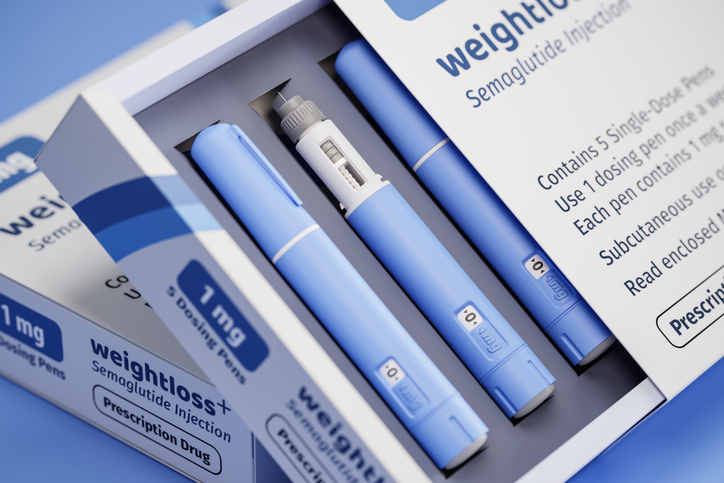Walmart’s revelation last October that it was seeing a “slight pullback” in spend from customers on GLP-1 weight loss drugs prompted a flurry of headlines about Ozempic’s impact on Big Food’s bottom line (although in Walmart’s case, the impact is balanced by profits made from selling these drugs at its pharmacies).
So is Ozempic “an existential threat to the processed food industry,” as Marion Nestle, emeritus professor of nutrition, food studies and public health at New York University recently told the New York Times, or an opportunity for creative food marketers and formulators to cash in?
It’s early days, but so far, three sets of tactics appear to be gaining traction in the food and supplement industry.
#1 – Re-positioning existing SKUs as ‘companion’ products for consumers on GLP-1 drugs, from gut health products to counter unpleasant GI side effects to supplements to mitigate nutrient gaps caused by reduced food intake.
#2 – Developing new portion-controlled, nutrient-rich, high-protein snacks or other products tailored to users of these drugs and those trying to wean themselves off said drugs without regaining all the weight, in part to counteract the muscle loss associated with taking these medications.
#3 – Exploiting consumer interest in resistant starch, prebiotic fibers and other ingredients that naturally boost satiety either by stimulating gut hormones such as GLP-1 or via other mechanisms. Unsurprisingly, some of the marketing around these products goes well beyond the current science, a strategy that could land some players in legal hot water.
Danone: ‘If anything, it will benefit our business’
For most companies, tactic #1 is the obvious starting point, with Daily Harvest recently debuting a GLP-1 Companion Food Collection “featuring dietitian-curated meals to complement one’s weight management journey” and weight management app Noom positioning itself as a “companion to help with adherence to the medication while avoiding muscle loss.”
Dairy giant Danone, meanwhile, says high-protein, low-fat dairy is ideal for Ozempic users, with deputy CEO Juergen Esser observing during the firm’s Q3 earnings call last year, that “If anything, it [the more widespread use of GLP-1 drugs] will benefit our business.”
He added: “People focusing on weight loss prefer obviously healthy products [according to Morgan Stanley research, Ozempic users are eating more fruit & veg and dairy and less confectionery, sugary drinks and alcohol]. They are looking for products with high-protein and low-fat content. And guess what, it’s exactly what we are proposing.”
Nestlé: ‘Demand for protein powders, drinks, and bars is increasing’
Nestlé, in turn, sees a big opportunity, said CEO Mark Schneider in a LinkedIn post last month. According to Schneider, Nestlé Health Science “already has more than 1.5 billion Swiss francs of revenue from products that provide nutritional benefits suitable to GLP-1 patients. This business is mainly focused on North America, where GLP-1 adoption is highest.
“We will build on this with a broader geographic rollout as well as additional companion products and offerings. New launches will happen as soon as 2024.”
As an example, he said, GLP-1 therapy can result in the loss of lean muscle mass. “One of the best ways to build and maintain lean muscle mass is protein intake and exercise, and we already see signs that demand for protein powders, drinks, and bars is increasing. Our North American brands like Vital Proteins, Orgain, and Boost address this protein need with diverse price points and protein sources, including a wide variety of plant-based solutions. This part of Nestlé Health Science’s business, which we call ‘Active Nutrition,’ is growing strongly.”
Meeting the vitamin and gut health needs of GLP-1 patients is also an area of opportunity, claimed Schneider. “Credible [dietary supplement] brands [owned by Nestlé] such as Pure, Solgar, Garden of Life, and Nature’s Bounty give us a strong shelf presence. They deliver both vitamins to mitigate any gaps from reduced food intake, and fiber, probiotics, and prebiotics that help with potential gastric discomfort and constipation side effects.
“And importantly, these brands have also helped us build a credible relationship with healthcare professionals, key partners in solving these challenges for GLP-1 patients.”
Mondelēz International: ‘The whole topic has been overblown’
At snacks and confectionery giant Mondelēz International, chairman and CEO Dirk Van de Put told analysts during his firm’s latest earnings call that “the whole topic has been overblown. We see absolutely no short-term impact on our results.”
Moreover, “even using the most optimistic forecast, we believe the impact will be very modest to our volumes in our categories,” speculated Van de Put, who has nevertheless dedicated “a special work stream to stay close” to the issue.
“We’re talking about 0.5% to 1% volume effect 10 years down the road… and that assumes quite significant adoption rates of the drug. Even if the impact would be bigger than that, I think over a 10-year period, it will be manageable, and we will have adequate lead time to adjust and prepare for any changes that we see.”
On a more practical note, he said, “Obesity rates around the world are very different, and we have one of the lowest exposures since 75% of our sales come from outside of the US and 40% of our sales are in emerging markets [where average BMIs are far lower]. So our exposure is significantly lower than some of the other food companies.”
Meanwhile, portion control is a big part of the company’s strategy, he added: “20% of our sales are already in snacks that are less than 200 calories.
“We have a large part of our portfolio that is chocolate, which is not hunger satisfaction, but it’s a small indulgence. And we have healthier alternatives for the breakfast occasion [such as] belVita, which is a replacement snack, or some of our snack bars, which are meal replacements, and that fit perfectly into the diet of GLP-1 patients.”
“With GLP-1 drugs, losing weight is definitely easier. But keeping it off after you stop taking the drug can be a big challenge. There is a big role for health tech in facilitating this transition. Companion digital solutions can help users develop new behaviors to ensure they’ve made a change that will stick for good.” Marni Allen, CMO, Bioniq
PepsiCo: ‘Negligible’ impact
At PepsiCo, so far at least, the impact of GLP-1 drugs has been “negligible,” CEO Ramon Laguarta told analysts during the firm’s latest earnings call. “Everything we’ve been doing for the last five, six years when it comes to reducing sodium, fat, sugar, reducing the portions of our products, adding some new cooking methods to our snacks, those are all very positive trends that will help us pivot the portfolio if needed in the future.
“And our portfolio strategy, we think, is very solid when it comes to a potential protection against some of these future developments five or 10 years from now.”
Hartman Group: Surge of inquiries from CPG cos after Walmart ‘pullback’ comment
Right now, most food companies are just trying to understand what this all means, says Melissa Abbott, VP syndicated studies at Hartman Group, a market research and consulting firm that specializes in the food and beverage industry.
“We’re getting a lot of questions [from CPG clients], with interest peaking after the comments from Walmart, so we started to look at some of the studies that we were conducting to see if we could add some questions for people taking these GLP-1 drugs.”
As for Hartman’s clients, she says, food and beverage companies have already been steadily cutting sugar from beverages, and reducing sugar, saturated fat, and sodium from many of their foods, so in many respects, GLP-1 drugs may just accelerate this trend.
“I think many beverage companies in particular feel like they’re already well-positioned [to accommodate potential changes in consumer habits from more widespread use of GLP-1 drugs] with their portfolios of low- and no-sugar options.
“The other thing we’re seeing is a lot of companies getting really excited about this idea of helping people who are not on these drugs or are coming off the drugs and needing to control their appetite.”
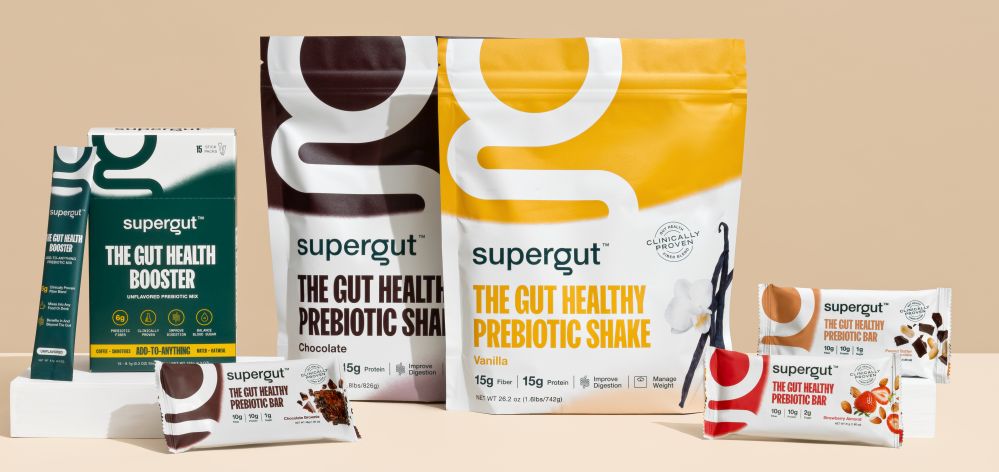
Supergut: Interest ‘off the charts’ following ‘Nature’s Ozempic’ positioning
One company currently capitalizing on a surge of consumer interest in natural alternatives to GLP-1 drugs is Supergut (formerly Muniq), a startup making bars and shakes containing a blend of resistant starches and prebiotic fibers that are fermented in the gut to produce short chain fatty acids. These in turn are claimed to stimulate production of GLP-1, the gut hormone associated with satiety that Ozempic-like drugs are mimicking.
Cofounder and CEO Marc Washington, who started pitching his wares as ‘Nature’s Ozempic’ a few months ago (a claim some legal experts have urged food brands to avoid), is now being inundated with inquiries as retailers such as Sprouts [which has just launched his brand nationwide] seek to capitalize on consumer interest in Supergut, which has historically been positioned as a gut health product.
“About four to five months ago, we decided that this [the ‘Nature’s Ozempic’ angle] was no longer a subhead, that cravings control is the headline. And since then we’ve gone absolute gangbusters, with listings in Sprouts, Erewhon and Bristol Farms and other significant retail launches coming up as well.”
Unusually for a brand of this size, Washington also has a human clinical study showing volunteers with type 2 diabetes consuming Supergut products demonstrated improved glycemic control and a small reduction in body weight in a 12-week study.
Washington concedes that the “order of magnitude is going to be significantly higher and the effects lasting far longer” if you’re taking Ozempic vs foods that naturally boost gut hormones. “These drugs are essentially bathing your body in these hormones for a week.” But he also notes that many people don’t want to take drugs, don’t meet the medical criteria for taking them, or can’t afford them.
There are also other benefits to consuming a mix of prebiotic fibers beyond stimulating satiety hormones, from improved gut health to general improvements in metabolic health, he observes, with resistant starch—long the unsung hero of nutrition science—finally getting its moment in the sunshine.
“It’s really hard to break through with messaging in this crowded, noisy environment,” especially with an ingredient called ‘resistant starch,’ which on the face of it doesn’t have obvious consumer appeal, he says. “So it’s fantastic that people are finally paying attention.”
Stepping back to look at the opportunity in snacks, he says, “I see Ozempic accelerating the pace of the ‘better for you’ trend, which has focused on macros like higher protein, less sugar, but I think it’s also going to really drive interest in truly functional foods.”
Formulating with resistant starch
As with any functional ingredient, meanwhile, he cautions, we should pay attention to how much is being used and whether the food matrix or formulation helps or hinders the active ingredients.
For example, resistant starches, which are found in foods such as potatoes, unripe bananas, tigernuts, and Jerusalem artichokes, ‘resist’ digestion in the small intestine and reach the large intestine, where they are fermented, generating their beneficial effects.
But if you’re selling green banana flour in a baking mix that is going to end up in a hot oven, or adding certain resistant starches to cereals that might be processed using high pressure or temperatures, the starch may not be resistant to digestion anymore, and the associated benefits will not be delivered, he points out. “How these ingredients are used and formulated really matters.”
Comet: GLP-1 is just part of the story…
Hannah Ackerman, a registered dietitian and director at Comet—a startup developing functional fibers and sweeteners from upcycled ingredients—adds: “The space is wide open for other biotic foods and drinks to appeal to consumers’ interest in mechanisms other than glucagon-like peptides that regulate appetite in the brain, improve insulin responses and improve satiety — or a feeling of fullness — well after a meal is consumed.
“Prebiotic fibers are in an ideal position to leverage this opportunity as they can improve insulin responses and satiety or a feeling of fullness after a meal. When bacteria ferment prebiotic fibers in the large intestine, it leads to the release of not only GLP-1 but also another crucial appetite-decreasing hormone known as PYY (peptide YY). These smaller molecules can independently suppress appetite and are associated with lower body weight and improved glucose regulation. Because the additional release of GLP-1 and PYY takes place hours after a meal, it effectively reduces cravings between meals and diminishes the overall desire to eat during the subsequent meal.”
But she cautioned: “It’s important to note that not all fiber is equal or can provide these benefits. To boost satiation hormones, you need to eat fiber that bacteria can digest, i.e., prebiotic fibers such as beta-glucan, arabinoxylan and oligosaccharides.”
Academic: Fermentable fibers are not going to have the same effect as drugs
Dr. Edward Deehan, assistant professor in the department of food science at the University of Nebraska-Lincoln, notes that there is a body of clinical research to support claims that fermentable fibers can promote satiety. Because they can be viscous these fibers have bulking effects and slow gastric emptying, which can also contribute to feeling fuller for longer, he observes.
“I’m doing some work with fiber from corn bran, and individuals consuming relatively high levels (25-30g/day) had greater feelings of satiety and needed less insulin to maintain blood glucose levels. There’s also research on psyllium fiber and feeling full and a highly viscous non-starch polysaccharide complex called PGX that increases [self-reported] feelings of satiety.”
But let’s get real, he says. “They’re not going to have the same effects as drugs such as Ozempic, which stay in the body at a lot higher levels.” Notably, semaglutide drugs—which mimic GLP-1—bind to GLP-1 receptors and activate them but have a much longer duration of action due to their structural modifications, which make them less susceptible to enzymatic degradation, he points out.
“Our bodies regulate GLP-1 with an enzyme [dipeptidyl peptidase-4] that cleaves it so it doesn’t last very long in the body. The medications resist that enzyme and stay in the body for far longer at much higher levels.”
Dr. Deehan also notes that reactions to fermentable fibers such as inulin (from chicory roots) and resistant starch (from foods such as green banana flour) vary significantly. “You can have one person that is consuming products containing these fibers that feels very satiated and another that sees no change, and we’re still trying to understand why that is. It likely reflect the microbes they have in their gut.”
But ultimately, he says, while short-term studies looking at the impact of fibers on short chain fatty acid production or the second meal effect* are valuable, the only real test of whether these ingredients amount to ‘Nature’s Ozempic’ is “looking at clinical endpoints, whether it’s weight loss, or insulin sensitivity, for example.”
*the ability of a food to impact consumption at a subsequent meal later in the day or the following day.
Akkermansia Muciniphila: Promising results for insulin sensitivity
As for Akkermansia Muciniphila, a bacterium claimed by trending supplement brand Pendulum to increase GLP-1 production, he says, “It’s a pretty promising microbe when it comes to insulin sensitivity, but I’ve not seen any human clinical data about Akkermansia, GLP-1 production and weight loss.”
On its website, the company (which includes actress Halle Berry among its investors) links to animal research showing that Akkermansia Muciniphila increased GLP-1 production in mice on a high-fat diet. When asked if it had any human clinical data to support its claims about weight management and GLP-1 production, a spokesman sent AgFunderNews links to three studies, although none of them demonstrated any weight loss effects.
The first was a review looking at the therapeutic potential of butyrate in treating type 2 diabetes; the second showed that a blend of probiotic strains including Akkermansia Muciniphila could improve postprandial glucose control in volunteers with type 2 diabetes; while the third showed the same blend triggered an increase in circulating butyrate.
Right now, observes SPINS in its 2024 trend-watching report, it’s probably too early to say whether some of these trending foods and supplements will retain their cache if consumers hoping to see drug-like weight loss effects become disillusioned if the pounds don’t fall off.
Sales of berberine supplements—which spiked as shoppers searched online for natural alternatives to Ozempic—have already started to cool down, for example.
That said, supplements providing daily nutrients may benefit from widespread use of appetite-suppressing drugs, predicts SPINS: “Instead of attempting to force yourself to eat a full meal when you aren’t hungry, it may be simpler to drink your nutrients or take daily pills instead.”
Smaller portions, more skyr and cottage cheese, less pasta
Dr. Devon Gholam, VP science and innovation at ingredient incubator and innovation firm Step Change Innovations, says she has noticed that some companies marketing ingredients that impact glucose control and weight management are finally “having a moment” in the Ozempic era, as consumers reading about GLP-1 drugs start looking for natural alternatives.
“I’m seeing more brands talk about metabolism and all these ingredients I’ve known about for years like fermentable fibers and resistant starches are being repurposed for the diabetic community.”
Dr. Gholam, who is herself taking Ozempic, says she has become more thoughtful about her diet since taking the drug, and is eating “smaller portions, more high-protein low-fat/sugar dairy products such as cottage cheese and skyr, more produce, and fewer empty carbs. The biggest change is eating earlier in the evening.”
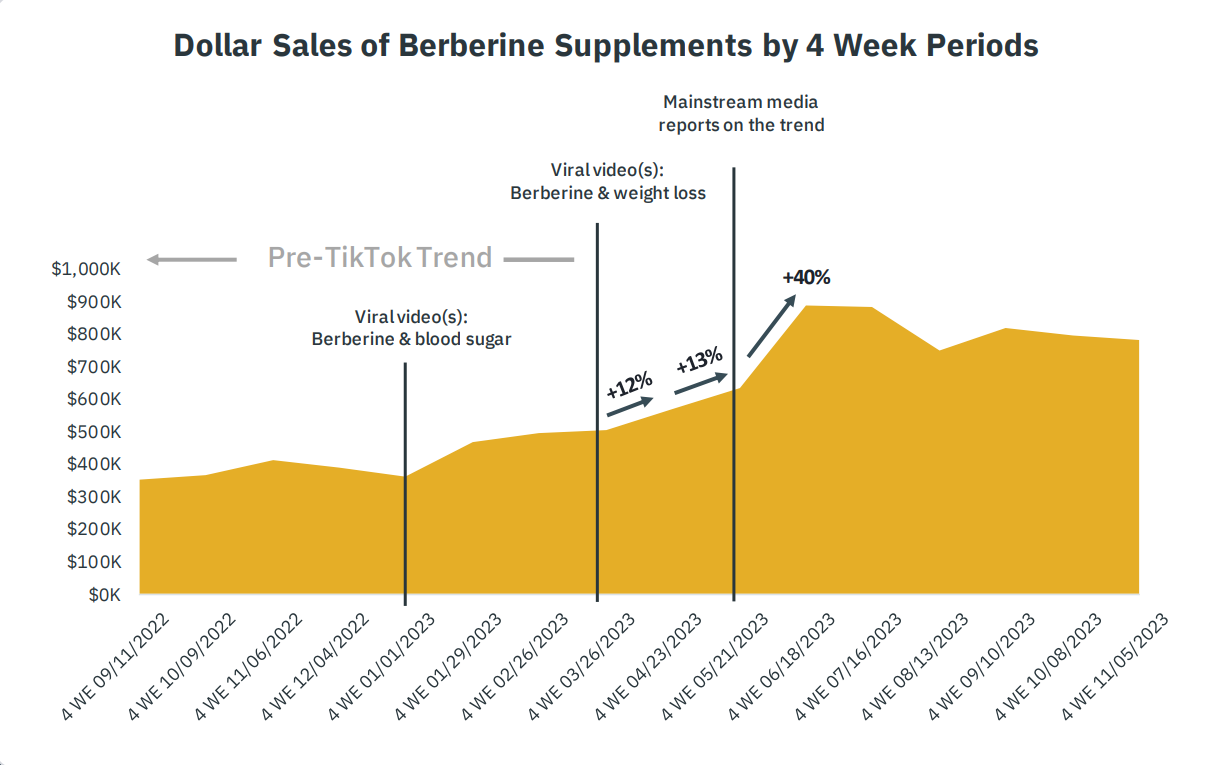
TD Cowen on semaglutide drugs: ‘Significant uncertainty around what level of uptake will be achieved’
So how are analysts that have researched semaglutide (Ozempic, Wegovy, Rybelsus) or tirzepatide (Mounjaro, Zepbound) drugs thinking about their broader impact on the food industry?
According to a report from TD Cowen penned in November, “there remains significant uncertainty around what level of uptake will be achieved in an addressable market that represents roughly one-fifth of the world’s adult population. Our 2030 estimates contemplate global penetration into the addressable type 2 diabetes and obesity markets of only 8% and 2%, respectively (from about 3% and 0.2% in 2023).”
Uptake would likely be greater if these drugs could be consumed in oral form rather than injected, adds the report, “An oral weight loss agent would likely be well-received in the primary care setting and could alleviate pressure on supply chains. It may also help to boost compliance when injectables are not preferred and could be priced lower to reach a broader swathe of patients, especially outside the United States.”
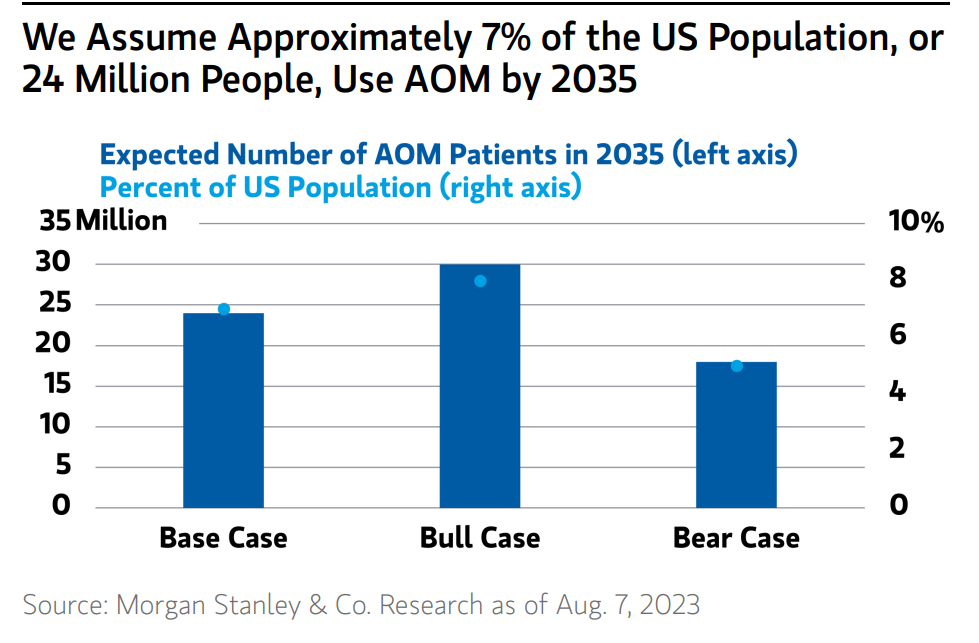
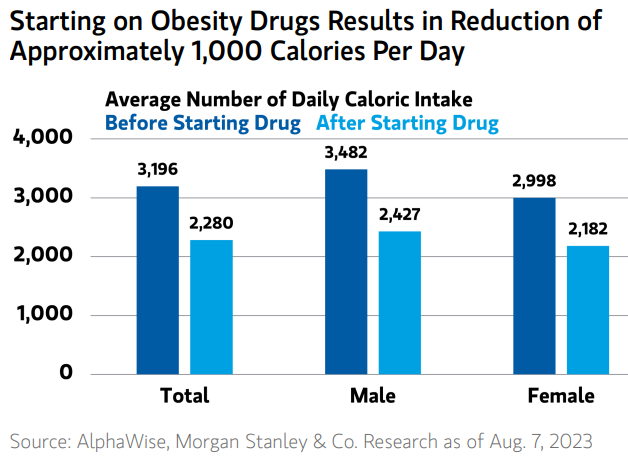
Morgan Stanley: ‘A broader and more lasting behavioral shift’
According to recent research from Morgan Stanley, its biopharma analysts expect the US anti-obesity medication (AOM) patient pool to increase fivefold to 24 million people (7% of the US population) over the next decade.
“This usage could drive a broader and more lasting behavioral shift among this large demographic—one that represents a disproportionate share of food consumption. Given the drugs’ impact on reducing appetites and calorie intake, increasing AOM prevalence can shape demand for food, beverages and restaurants, and we anticipate meaningful impact in areas such as packaged food and beverages, restaurants, grocery stores and weight loss programs.”
While it’s early days, AOM patients report a 23% reduction in daily meals and 50% reduction in snacks, according to Morgan Stanley.
“Our research points to a decline in consumption across food and beverage categories, but a more pronounced reduction in sugary drinks, confectionery, baked goods and salty snacks. We also see a shift away from fast-food restaurants.”

1%-to-2% impact on annual calories consumed by 2035
Morgan Stanley’s US modeling predicts a 1%-to-2% impact on annual calories consumed by 2035. “Assuming that there are 24 million individuals treated with AOM by 2035 and that on average people lose 17.5% of their body weight, we estimate a 1.3% reduction in calories consumed relative to the status quo.
“We assume a 20% reduction in calorie consumption among AOM patients after their weight loss, relative to their original calorie intake; our model assumes a 25% annual attrition rate, and that lapsed patients regain about two-thirds of the weight lost.”
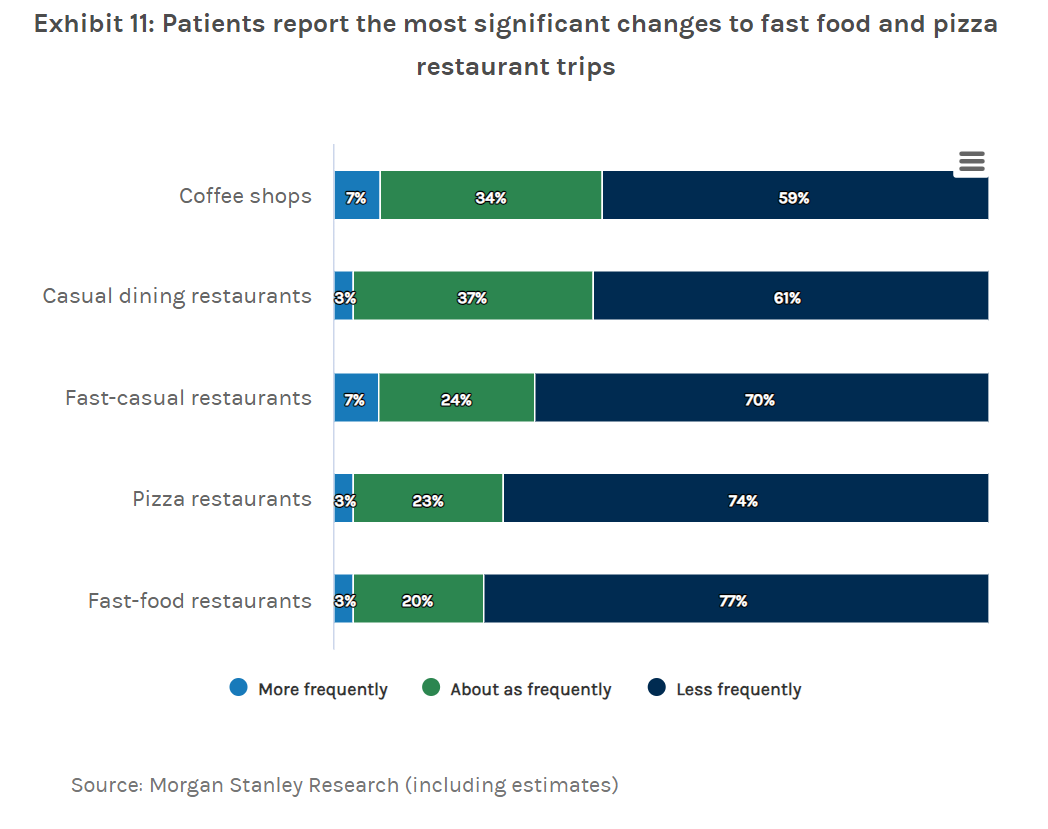
Household impacts
While survey data focuses on people taking obesity medicines, we could see a greater change to food consumption if the behavioral changes affect people in AOM patients’ households or social circles, speculates Morgan Stanley.
“If people on obesity medication are responsible for household food purchases, they may buy different products for family members as well, such as fewer sugary drinks or snacks. In addition, since they report cutting back on fast-food visits, they could be frequenting these places with significant others or children less often.”
The report adds: “Obesity drug patients reported cutting back considerably on both nonalcoholic and alcoholic beverages, with 65% consuming fewer sugary carbonated drinks and 62% drinking less alcohol. Nearly a quarter stopped drinking alcohol entirely and nearly 20% gave up sugary drinks. Analysts see US focused alcohol companies facing the most exposure from increased obesity medicine usage and expect a roughly 2% drop in consumption by 2035.”
As for GLP-1 drug users, survey data from the Brightfield Group suggests that a “substantial portion” are “city dwellers with higher incomes that are actively engaged in exercise and diet management,” while a recent survey of 2,000 US consumers from direct-to-consumer company Daily Harvest found that GLP-1 drugs were more appealing to those with self-described “very healthy” diets.
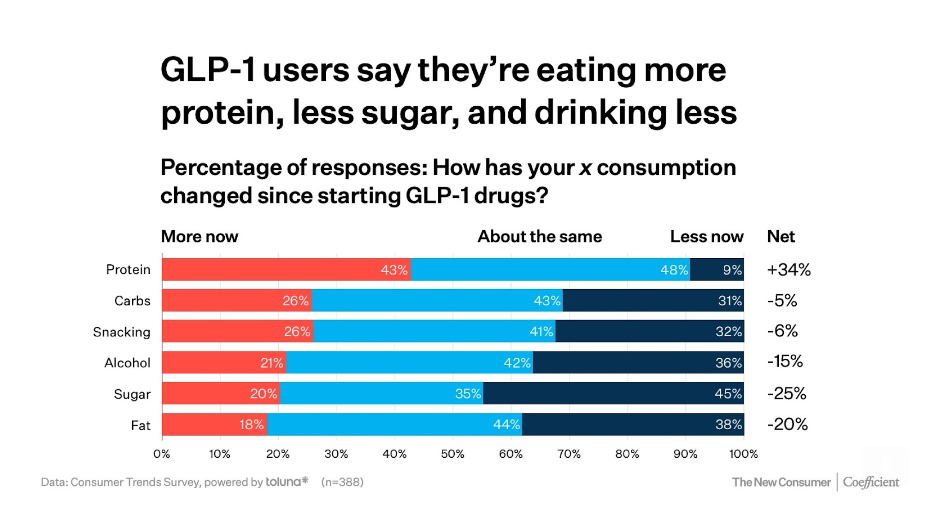
Rabobank: ‘It’s way too early to draw conclusions’
However, Nick Fereday, senior analyst, consumer foods at Rabobank, says we should be careful about making sweeping predictions about the future of the food industry based on preliminary survey data from a relatively small number of GLP-1 drug users.
It is also hard to predict how people will think about these drugs over the long term, with a recent study by The New Consumer and Coefficient Capital showing that 46% of 1,810 consumers aware of GLP-1 weight loss drugs are ‘extremely’ or ‘very’ concerned about their long-term health impact, a figure that rises to 51% among users of such drugs (n-388). A further 37% are ‘somewhat’ concerned.
Meanwhile, 51% of the GLP-1 drug users in the same survey say they plan to “go on and off the medication based upon my needs.”
There are also concerns about the long-term effects of these drugs, adds Ackerman at Comet. “Questions remain concerning the drugs’ long-term effects on the body, in particular the GI tract. By constantly signaling to the brain that the body is full, peristalsis (rippling GI waves that push contents through the gut) is slowed, thereby disrupting the body’s natural digestion process.”
According to Fereday: “The anecdotes of the early adopters are not necessarily that representative of how things will play out if this class of drugs goes mainstream. Media speculation that these drugs are going to devastate the food industry is very overblown… it is way too early to draw conclusions.”
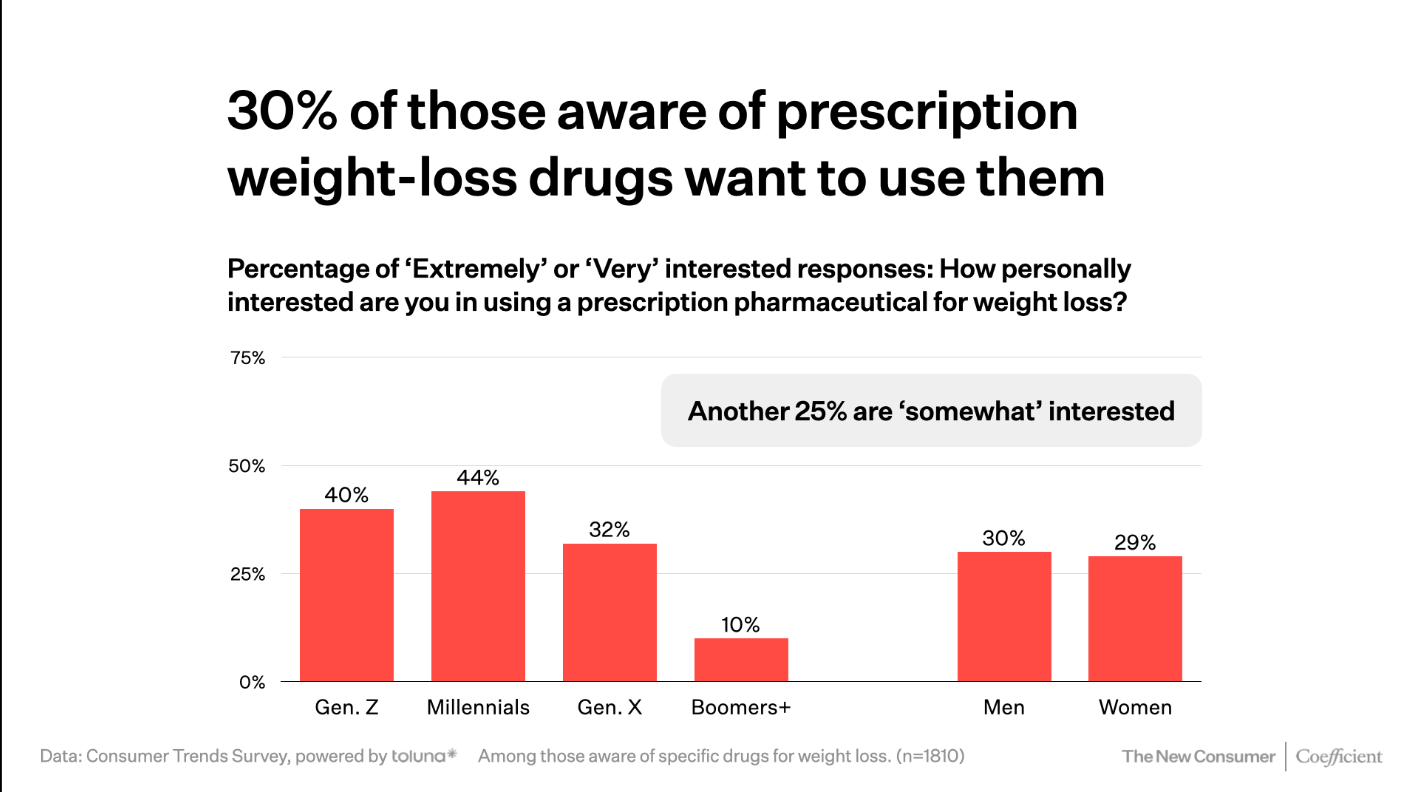
Hartman Group: A new cultural moment?
Abbott at The Hartman Group also stresses that it’s very early to make sweeping judgments about GLP-1 drugs’ impact on food culture, although early indications are that they are beginning to change the conversation about weight management.
“What these drugs seem to be doing is creating a cultural moment where consumers are thinking more about losing weight. It’s not just ‘I want to feel good,’ but ‘I actually want to look a certain way too,’ which is a bit of a rebound from where we’ve been in recent years [where brands in the weight management space have markedly shifted their marketing from dieting and weight loss to wellness and weight management].”

